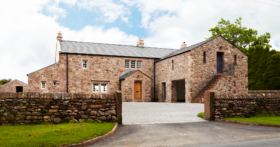
21st-22nd February 2026 - time to get your dream home started!
BOOK HERE
21st-22nd February 2026 - time to get your dream home started!
BOOK HEREPlanning policy at both government and local level has always had a strong bias towards conserving the built heritage. The process of recognising and protecting buildings and areas of historic interest is long established through the listing of buildings and designation of conservation areas, which present both opportunities and challenges for self-builders.
‘Conservation area’ is a national, statutory designation, so there are special laws protecting such areas that apply throughout the country. Key points are a requirement for all new development to ‘preserve or enhance’ the conservation area’s special character; a need to get special conservation area consent for most kinds of demolition, including even garden walls, and a restriction on permitted development rights.
Whether you’re looking to build on an infill plot, convert or refurbish an existing building or demolish and replace, it’s therefore essential that you know whether the property is in a conservation area. You can find this out from the maps attached to your local council’s local plan or new-style local development framework, which show the extent of all conservation areas in the district or borough. Many councils also have documents detailing the particular characteristics of their conservation areas.
Central to all conservation-area building projects is ensuring that all new development ‘preserves or enhances’ the character of a conservation area. Whether a new building or alteration to an existing one enhances or harms prevailing character is an inevitably subjective judgment and many an appeal and court case has resulted from disagreements over how the criteria should be interpreted. The courts have held that ‘preserve or enhance’ requirement should be interpreted, simply as ‘not harm’ which makes life a little easier.
Demolition of any building in a conservation area, including outbuildings and walls, requires conservation area consent, in addition to any planning permission for what you want to build. In practice this means you must show that whatever you want to take down isn’t an important part of the conservation area’s character, and that you’re replacing it with something of suitable quality. Usually councils won’t grant consent to demolish a building until they know what’s going in its place.
The key to getting permission for new buildings is to respect prevailing character. Take account of the whims of the council’s conservation officer and ensure you employ a building designer with the necessary skill and experience for conservation area work. Top quality drawings are a major benefit. You may have to pay extra for the right sorts of materials as well.
Bear in mind that it’s not just the buildings that make up the character of a conservation area, but the spaces in between them as well. What could appear to be a suitable gap between buildings for an infill house might be regarded by the planners as an important open space that contributes to the special character of the area or allows a view of something interesting. Similarly trees and hedges might be seen as integral parts of that character as well. Note that all trees in a conservation area (except fruit trees) are protected from felling in the same way as if they were subject to tree preservation orders.
A final point to consider is that sometimes an existing building in a conservation area is completely out of character or an eyesore. In such cases the positive benefits of replacing the building with something far more attractive can outweigh other planning considerations –such as whether there’s enough parking or amenity space – that might thwart a similar scheme elsewhere.


Comments are closed.